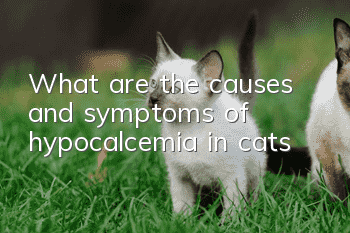What are the causes and symptoms of hypocalcemia in cats?

What causes hypocalcemia in cats
Hypocalcemia is more common in female dogs or cats that have given birth to multiple fetuses. Affected female cats usually have sudden generalized cramps after giving birth, which is a serious metabolic disease. Let’s also take a look at the causes of this disease.
Calcium deficiency is the main cause of this disease. On the one hand, because most of the food is artificially prepared, mainly meat, liver and cereals, with a small amount of vegetables added, the female cat absorbs less calcium from the intestines or is deficient in calcium, resulting in insufficient calcium supplementation before and after giving birth.
On the other hand, after the female cat gives birth, a large amount of calcium enters the milk due to large amounts of lactation. The blood calcium concentration of the female cat decreases significantly, and the neuromuscular excitability increases, thus causing muscle tremor and spasm. Furthermore, cats like to be quiet and are not good at exercising. Activities are limited to carpets, tiles, balconies, sofas, and paving circles, and the buildings lack sunlight and exercise.
What are the symptoms of feline hypocalcemia
Feline hypocalcemia is more common in postpartum female cats, and the number of litters is high. The main cause of this disease is the lack of calcium. Therefore, we should appropriately supplement calcium for postpartum female cats to avoid postpartum cramps and hypocalcemia.
Hypocalcemia occurs very quickly, usually within 15 to 25 days of breastfeeding. Cats suffering from the disease initially show restlessness, running around, and fear. Later, they develop a staggering gait, stiff hindquarters, and ataxia. Then they suddenly fall to the ground, their limbs straighten, their body temperature rises to 41°C to 42°C, and their muscles all over the body experience tonic spasms. Foaming at the mouth, white foam or saliva adhering to the corners of the mouth, opisthotonia, constant opening and closing of the mouth, rapid breathing, eyeballs turning upward, visible mucosal congestion, occasional whining, slow pulse, and increased heart palpitations. The time from the onset of symptoms to the onset of convulsions in a female cat ranges from about 15 minutes to about 12 hours. The course of the disease is rapid. If not treated in time, she will die of suffocation in more than 1 to 2 days.
Therefore, supplementing enough calcium and vitamin D during pregnancy and lactation will help the health of mother cats and kittens. If the above symptoms are found, go to the veterinary hospital as soon as possible for intravenous calcium supplementation.
Treatment of feline hypocalcemia
Mild hypocalcemia does not have a great impact on cats, but in severe cases, the disease may threaten the cat's life. Therefore, we cannot take this disease lightly. If a cat has similar symptoms, it should be examined and treated as soon as possible to avoid delaying the condition.
Based on the female cat’s clinical symptoms, incidence patterns and various causes of the disease, symptomatic treatment and feeding management are combined, and early calcium supplementation, antispasmodic and sedative are adopted to enhance the body’s resistance and prevent respiratory obstruction. Prevention.
1. Calcium supplement
Use 10% calcium gluconate solution or 10% borate calcium gluconate solution 0.5~1mL/kg body weight, add 100 mL 5% glucose solution and infuse slowly intravenously, once/d, for 3 to 5 days. After the condition is relieved, you can take calcium lactate, calcium carbonate or calcium gluconate tablets 0.5~1.0g/time and 5~10 mL/time of cod liver oil orally every day for 3~4 weeks.
2. Anti-spasmodic
For cases of persistent spasm, 25% magnesium sulfate solution 0.1mL/kg body weight can be injected intravenously, and the spasm can be effectively relieved or relieved.
3. Calm
For cats suffering from mania and restlessness, 3%~5% pentobarbital solution can be injected intravenously at 3~5mg/kg body weight, or chlorpromazine hydrochloride can be injected intravenously at 0.5~1mg/kg body weight.
4. Sugar supplement
In order to relieve hypoglycemia secondary to hypocalcemia and enhance the body's resistance, 10% glucose solution can be intravenously dripped at 5~10mL/kg body weight. Glucose solution can also be taken orally. If the sick cat has poor appetite, it can be given by gavage with white sugar water (60g white sugar, 300mL warm water), 1 to 2 times/day for 2 to 4 days, which has a good effect.
At the same time, in order to promote the mother's absorption of calcium and enhance the body's health, it is necessary to strengthen outdoor exercise and receive sunlight to promote the formation of VD in the body. In order to ensure that the mother cat breastfeeds her kittens, enables the kittens to grow healthily, and prevents the cats from recurring seizures, the sick cats can be given oral prednisolone 0.5 mg/kg of body weight. Or the female cats are kept separately, but the kittens must be given supplementary food to reduce their milk requirements.
- A cat will die if it urinates for a few days
- Should you deworm yourself or go to a pet store?
- Are cat teasers harmful to cats?
- What should I do if my cat suffers from chronic gingivitis?
- Cat's nails are cracked with a thin layer
- Cats go crazy after eating mutton
- What does cat moss on a cat’s chin look like?
- Can cats reproduce after abdominal transmission is cured?
- What exactly is the sterilization shot for female cats?
- Can I still eat unopened cat food if it has expired?



